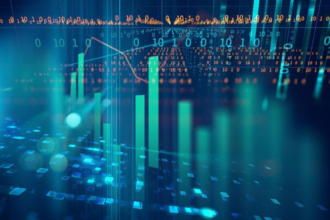Introduction
In the world of trading, identifying patterns in market behavior is essential for success. One technique that has gained popularity among traders is fractal analysis. Fractals are patterns that repeat themselves at different scales, and they can be used to identify potential trend reversals and other patterns in the market. In this article, we’ll explore the power of fractals in trading and how they can help traders make more informed decisions.
What are Fractals?
Fractals are geometric patterns that repeat themselves at different scales. In trading, fractals are used to identify patterns in market behavior that can be used to predict future price movements. For example, a fractal might be a pattern of price movements over a series of bars, with the middle bar being the highest or lowest in the series. When the price breaks above or below the fractal, it is considered a signal that the market may be changing direction.
Fractals are often used in conjunction with other technical indicators, such as moving averages and trend lines, to confirm signals and improve the accuracy of trading decisions. By identifying fractal patterns in market behavior, traders can gain a better understanding of the market and make more informed decisions which can be particularly beneficial for participants in funded traded programs.
Identifying Patterns with Fractal Analysis
Fractal analysis involves identifying patterns in market behavior that repeat themselves at different scales. For example, a fractal might be a pattern of price movements over a series of bars, with the middle bar being the highest or lowest in the series. When the price breaks above or below the fractal, it is considered a signal that the market may be changing direction.
Fractal analysis can be used to identify potential trend reversals and other patterns in the market. By identifying repeating fractal patterns, traders can gain insight into the behavior of the market and make more informed trading decisions.
Why Use Fractals in Trading: A Comparison to Similar Trading Methods
While there are many technical analysis tools available to traders, fractal analysis offers a unique perspective on market behavior. Unlike traditional indicators such as moving averages or RSI, fractals are based on the idea of self-similarity across different time frames. This means that patterns that emerge at one scale may repeat at larger or smaller scales, providing insights into the behavior of the market that may not be apparent with other indicators.
Compared to other methods of technical analysis, fractals are also relatively easy to use and interpret. They provide clear signals for trend reversals and support and resistance levels, making it easier for traders to make informed decisions. Additionally, fractals can be used in conjunction with other indicators to confirm signals and improve the accuracy of trading decisions.
While there are limitations to using fractals in trading, such as the reliance on historical price movements and the need for experience and expertise, they offer a powerful tool for identifying patterns in market behavior and predicting future price movements. In the next section, we’ll explore how fractals work and how to identify patterns using fractal analysis.
Advantages and Limitations of Fractal Analysis
One of the advantages of using fractals in trading is that they can be used to identify potential trend reversals and other patterns in the market. This can help traders make more informed decisions about when to enter and exit trades.
However, there are also limitations to fractal analysis. For example, fractals are based on historical price movements and may not always be accurate predictors of future price movements. Additionally, fractals can be complex and difficult to interpret, requiring a significant amount of expertise and experience to use effectively.
To mitigate these limitations, traders should use fractals in conjunction with other technical indicators and analysis techniques to improve their accuracy and effectiveness.
Conclusion
Fractal analysis is a powerful tool for identifying patterns in market behavior and predicting future price movements. By analyzing the self-similarity of price movements across different time frames, traders can gain insights into the behavior of the market and make more informed trading decisions. Fractals can be used to identify potential trend reversals, support and resistance levels, and other key patterns in the market, and can be used in conjunction with other technical indicators to confirm signals and improve the accuracy of trading decisions.
However, using fractals in trading requires a significant amount of expertise and experience. Fractals can be complex and difficult to interpret, and
Despite these limitations, fractals remain a valuable tool for traders looking to gain a deeper understanding of the behavior of the market. By incorporating fractals into their trading strategy, traders can improve their ability to identify patterns in market behavior and make more informed trading decisions. Remember, there is no one-size-fits-all approach to trading, and what works for one trader may not work for another. It’s important to develop your own trading style and strategy based on your individual goals, risk tolerance, and trading experience. By incorporating fractals into your technical analysis toolkit, you can gain a deeper understanding of the behavior of the market and improve your ability to make informed trading decisions.














